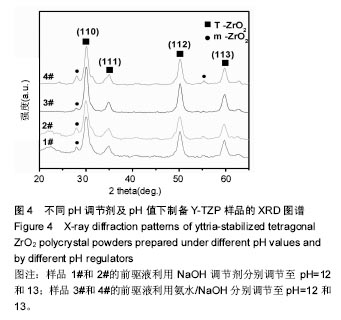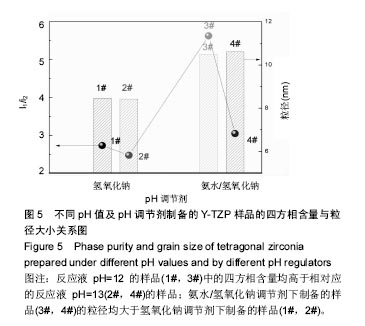| [1]Eraslan O, Aykent F, Yücel MT, et al. The finite element analysis of effect of ferrulebeight on stress distribution at post-and-core-restored all-ceramic antertior crowns. Clin Oral Investing.2009;13(2):223-227. [2]Yamashita D, Machigashira M, Miyamoto M. Effect of surface roughness on initial responses of osteoblast-like cells on two types of zirconia. Dent Mater J.2009;28(4):461-470. [3]禹立强,李金源.二氧化锆全瓷冠与传统冠修复体对牙周健康的影响[J].河北联合大学学报,2012,14(4):485-486.[4]Kelly JR, Denry I. Stabilized zirconia as a structural ceramic: an overview. Dent Mater.2008;24(3):289-298.[5]Denry I. How and when does fabrication damage adversely affect the clinical performance of ceramic restorations? Dent Mater.2013;29(1):85-96.[6]Chintapalli RK, Mestra Rodriguez A, Garcia Marro F, et al. Effect of sandblasting and residual stress on strength of zirconia for restorative dentistry applications. J MechBehav Biomed. 2014;29(29):126-137.[7]Sarker D, Mohapatra D, Ray S, et al. Nanostructured Al2O3-ZrO2 composite synthesized by sol-gel technique: powder processing and microstructure. JMartSci.2007; 42(5):1847-1855.[8]Nobuaki A, Keiichi Y, Takash S. Effects of air abrasion with alumina or glass beads on surface characteristics of CAD/CAM composite materials and the bond strength of resin cements. J Appl Oral Sci. 2015;23(6):629-636.[9]Naumova EA, Schneider S, Arnold WH, et al. Wear behavior of ceramic CAD/CAM crowns and natural antagonists. Materials (Basel). 2017;10(3):244.[10]Abduo J, Lyons K. Rationale for the use of CAD/CAM technology in implant prosthodontics. Int J Dent. 2013; 2013: 768121.[11]Nawaf Z, Saleh A, Haitham A. Standards of teeth preparations for anterior resin bonded all-ceramic crowns in private dental practice in Jordan. J Appl Oral Sci. 2011;19(4):370-377.[12]Borba M, Maico D, Lima E, et al. Flexural strength and failure modes of layered ceramic structures. Dent Mater. 2011; 27(12):1259-1266.[13]Moura L, Cesar F, Oliveira A, et al. Internal fit of two all-ceramic systems and metal-ceramic crowns. J Appl Oral Sci. 2012;20(2):235-240.[14]Guilardi LF, Pereira GK, Gündel A, et al. Surface micro-morphology, phase transformation, and mechanical reliability of ground and aged monolithic zirconia ceramic. J Mech Behav Biomed.2017;65:849-856.[15]Sutharsini U, Thanihaichelvan M, Ting C H, et al. Effect of two-step sintering on the hydrothermal ageing resistance of tetragonal zirconia polycrystals. CeramInt. 2017;43(10): 7594-7599.[16]Peng MD, Wei JQ, Wang YN, et al. Microstructure and nanoindentation analyses of low-temperature aging on the zirconia-porcelain interface. J MechBehav Biomed Mater. 2017;66:119-126.[17]Hallmann L, Ulmer P, Reusser E, et al. Effect of dopants and sintering temperature on microstructure and low temperature degradation of dental Y-TZP-zirconia. J Eur Ceram Soc. 2012; 32(16):4091-4104.[18]Zhang F, Vanmeensel K, Inokoshi M, et al. Critical influence of alumina content on the low temperature degradation of 2-3 mol% yttria-stabilized TZP for dental restorations. J Euro Ceram Soc. 2015; 35(2):741-750.[19]Xue WJ, Xie ZP, Yi J, et al. Critical grain size and fracture toughness of 2 mol% yttria-stabilized zirconia at ambient and cryogenic temperatures. Scripta Mater. 2012;67(12):963-966.[20]Jiang L, Guo S, Qiao M, et al. Study on the structure and mechanical properties of magnesia partially stabilized zirconia during cyclic heating and cooling. MaterLett. 2017;194:26-29.[21]Denry I, Kelly JR. State of the art of zirconia for dental applications. Dent Mater.2008;24(3):299-307.[22]Merk S, Wagner C, Stock V, et al. Retention load values of telescopic crowns made of Y-TZP and CoCr with Y-TZP secondary crowns: impact of different taper angles. Materials (Basel).2016;9(5):354.[23]Tong H,Tanaka CB, Kaizer MR, et al. Characterization of three commercial Y-TZP ceramics produced for their high-translucency, high-strength and high-surface area. Ceram Int. 2016;42(1):1077-1085.[24]Ahn JS, Yi YA, Lee Y, et al. Shear Bond strength of MDP-containing self-adhesive resin cement and Y-TZP ceramics: effect of phosphate monomer-containing primers. Biomed Res Int. 2015;2015:389234.[25]赵克,巢永烈,杨争.牙科用氧化锆增韧纳米复相铝瓷粉体的制备与性能研究[J].中华口腔医学杂志,2003,38(5): 384-386.[26]郑美华,张雯,罗彰,等.上前牙全瓷桥抗折性的正交试验[J].中华口腔医学研究杂志(电子版), 2013,7(4):299-304.[27]Yang HZ, Han LZ, Zhao LA, et al. Optimization of experimental parameters to the formation of ZrO2 phase via hydrothermal method. Adv Mat Res. 2011;328:1499-1502.[28]Thompson JY, Stoner BR, Piascik JR, et al. Adhesion/ cementation to zirconia and other non-silicate ceramics: where are we now? Dent Mater. 2011;27(1):71-82.[29]Borgonovo AE, Censi R, Vavassori V, et al. Evaluation of the success criteria for zirconia dental implants: a four-year clinical and radiological study. Int J Dent. 2013; 2013: 463073.[30]Ji Y, Zhang XD, Wang XC, et al. Zirconia bioceramics as all-ceramic crowns materials: a review. Rev Adv Mater Sci. 2013;34(1):72-78.[31]Al-Fahdawi MQ, Rasedee A, Al-Qubaisi MS, et al.Cytotoxicity and physicochemical characterization of iron–manganese- doped sulfated zirconia nanoparticles. Int J Nanomedicine. 2015;10:5739-5750.[32]Wang C, Niu LN, Wang YJ, ET AL. Bonding of resin cement to zirconia with high pressure primer coating. PLoS One. 2014; 9(7): e101174.[33]Borgonovo AE, Fabbri A, Vavassori V, et al. Multiple teeth replacement with endosseous one-piece yttrium-stabilized zirconia dental implants.Med Oral Patol Oral Cir Bucal. 2012; 17(6): e981-e987.[34]Siavikis G, Behr M, Zel JM, et al. Influence of heat treatment and veneering on the storage modulus and surface of zirconia ceramic. Eur J Dent. 2011 Apr; 5(2):191-198.Anunmana C, Anusavice KJ, Mecholsky JJ. Interfacial toughness of bilayer dental ceramics based on a short-bar, chevron-notch test. Dent Mater. 2010;26(2):111. |
.jpg)




.jpg)
.jpg)
.jpg)
.jpg)